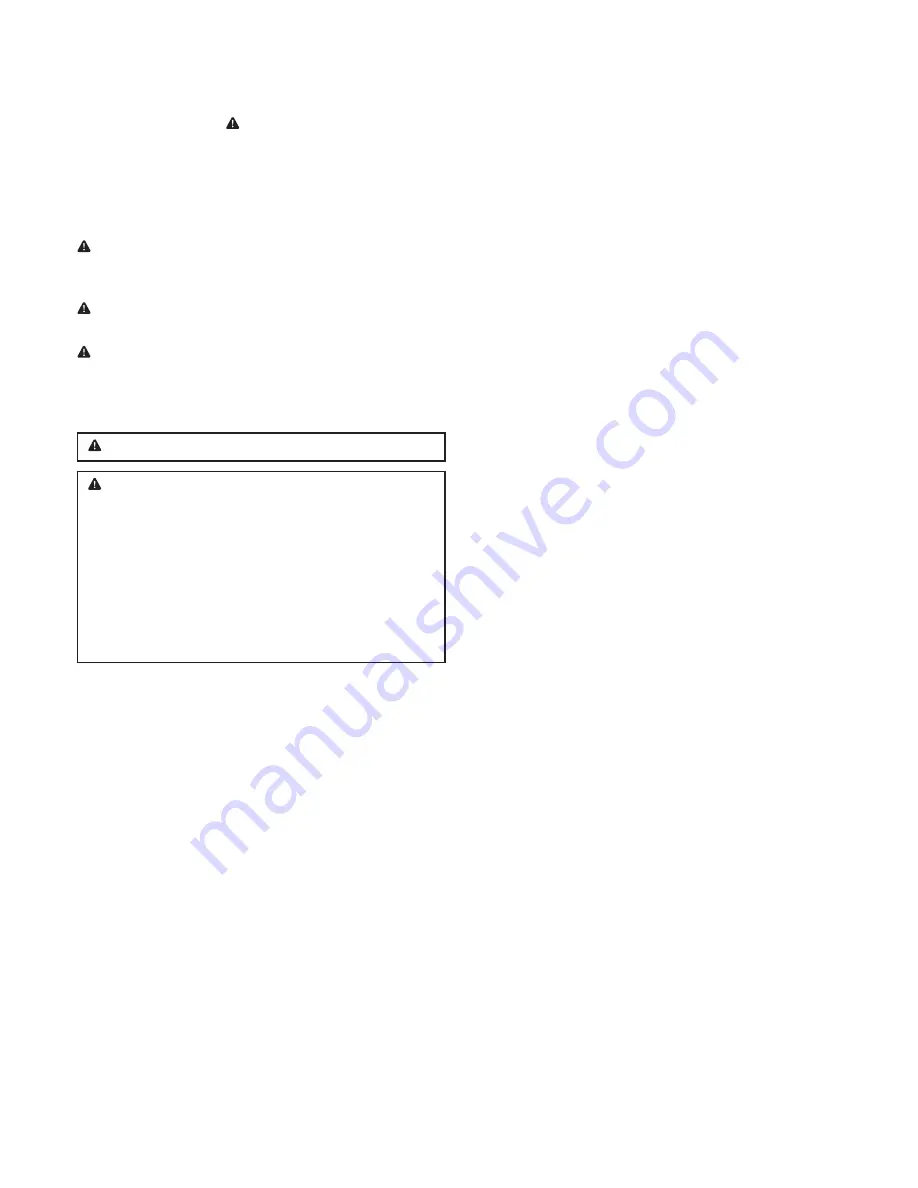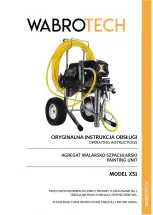
3
8. Do not operate the tool if it is damaged during
shipping, handling or use. Damage could result in
bursting and cause injury and/or property damage.
9. Never spray flammable materials in vicinity of open
flame or near ignition sources. Never store flammable
liquids or gases near air compressor.
10. Maintain a distance of at least 25 feet from the air
compressor. If possible, locate the air compressor in
a separate room.
11. Do not spray acids, corrosive materials, toxic chemi-
cals, fertilizers or pesticides. Using these materials
could result in death or serious injury.
12. Never aim or spray at yourself or anyone else, which
could result in serious injury.
13. Do not use pressure exceeding the operating
pressure of any of the parts (hoses, fittings, etc.) in
the painting system.
14. Do not smoke in or near the work area. Always keep a
fire extinguisher present in the work area.
15. During cleaning and flushing, solvents can be
forcefully expelled from liquid and air passages which
could cause eye injury. Be sure that all others in the
area are wearing impact resistance eye and face
protection. Even small objects can injure eyes and
cause blindness.
16. Paints and solvents may be harmful or fatal if
swallowed or inhaled. Avoid prolonged skin contact
with solvents or paints as they will irritate skin. After
any contact, immediately wash off exposed area with
hot, soapy water.
17. Always shut off air supply, drain hose of air pressure
and disconnect air supply when not in use, before
changing accessories or when making repairs. Turn
off and detach the air supply, safely discharge any
residual air pressure, and release the throttle and/or
turn the switch to its off position before leaving the
work area.
18. Keep hose away from sharp objects. Bursting air hose
could result in personal injury. Examine air hoses
regularly and replace them if damaged or broken.
Spray gun safety instructions
1. Check for misalignment or binding of moving parts,
breakage of parts, and any other condition that
affects the tool's operation. If damaged, have the tool
serviced before using.
2. Always use spray gun at a safe distance from other
people in the work area.
3. Clean the spray gun IMMEDIATELY after each use.
Delayed or inadequate cleaning will permanently clog
the spray gun.
4. The pressure for atomization is controlled by the
regulator on the air source. The amount of fluid is
adjusted by the fluid control knob, the paint viscosity,
and the air pressure.
5. Failure to install appropriate water/oil removal
equipment could result in damage to the product or
workpiece.
1. Keep the work area clean and well lighted. Cluttered
benches and dark areas increase the risks of electric
shock, fire and injury to persons.
2. Keep bystanders, children and visitors away while
operating the tool. Do not use this product with other
people, children or pets in the work area.
3. Stay alert. Watch what you are doing and use
common sense when operating the tool. Do not use
the tool while tired or under influence of drugs,
alcohol, or medication.
4. Dress properly. Do not wear loose clothing or
jewelry. Keep long hair and gloves away from moving
parts.
5. Do not overreach. Keep proper footing and balance at
all times. Use a face mask/respirator and wear
ANSI-approved safety goggles when spraying. Always
spray in a well-ventilated area to prevent health and
fire hazards. Refer to Material Safety Data (MSDS) of
spray materials for details.
6. Never use oxygen, carbon dioxide, combustible gases
or any bottled gas as an air source for the tool. Use
only clean, dry, regulated compressed air at the rated
pressure or within the rated pressure ranges for best
spray gun performance and extend spray gun life.
7. Do not aim the spray gun at any dust or debris to
avoid any damage to workpiece.
General Safety Information
●
Improper operation or maintenance of spray guns
could result in serious injury and/or property damage.
Read and understand all warnings and operation
instructions before using spray guns. When using
spray guns, basic safety precautions should always
be followed to reduce the risk of personal injury.
●
Follow all local electrical and safety codes as well as
the United States National Electrical Codes (NEC) and
Occupational Safety and Health Act (OSHA).
The safety alert symbol is used to identify safety
information about hazards that can result in personal
injury.
A signal word
DANGER
,
WARNING
or
CAUTION
is used
with the alert symbol to indicate the likelihood and the
potential severity of injury.
DANGER
Indicates a hazardous situation that, if not
avoided, will result in death or serious injury. This signal
word is to be limited to the most extreme situations.
WARNING
Indicates a hazardous situation that, if not
avoided, could result in death or serious injury.
CAUTION
Indicates a hazardous situation that, if not
avoided, could result in minor or moderate injury.
NOTICE
Indicates information considered important, but
not hazard-related.
WARNING
WARNING
Read manufacturer's instructions.
Not
for
Reproduction



























